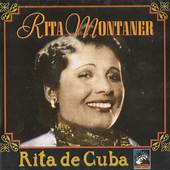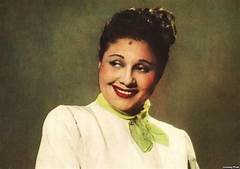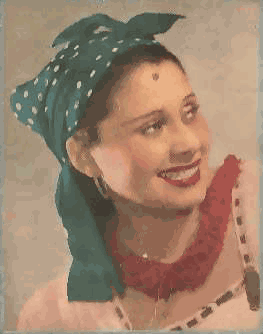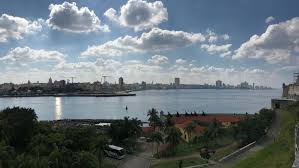RITA MONTANER “LA UNICA”, CANTANTE, PIANISTA Y ACTRIZ CUBANA. PHOTOS. VIDEOS
Rita Aurelia Fulcida Montaner y Facenda conocida como Rita Montaner, fue una cantante, pianista y actriz cubana. En el lenguaje cubano, era una vedette (una estrella), y era muy conocida en la Ciudad de México, París, Miami y Nueva York, donde actuó, filmó y grabó en numerosas ocasiones. Fue una de las artistas más populares de Cuba entre finales de la década de 1920 y 1950, conocida como Rita de Cuba. Aunque recibió una formación clásica como soprano para zarzuelas, dejó su huella como cantante de canciones de salón afrocubanas como “The Peanut Vendor” y “Siboney”.
A lo largo de su carrera, Montaner mantuvo una estrecha relación personal y profesional con dos destacados músicos de su Guanabacoa natal: el pianista y cantante Bola de Nieve y el compositor Ernesto Lecuona. En 1933 lanza a su pianista acompañante, Bola de Nieve (Ignacio Villa), como solista.
Rita “La Única”, nacida el 20 August 1900, fue una de las más grandes artistas cubanas, incursionó en el teatro, la radio, el cine y la televisión alcanzando notable éxito nacional e internacional. Hija de un blanco y una mulata creció en un ambiente mezclado por la cultura europea y la africana. Comenzó sus estudios de piano en el Conservatorio “Peyrellade”, en el cual obtuvo la Medalla de Oro con solo 13 años de edad. Se graduó de piano, canto y armonía en 1917. Al graduarse se dedicó al canto aunque muchos le decían que tenía un buen futuro en el piano.
VIDEO- Rita Montaner canta “Ay Jose”..
RITA MONTANER “LA UNICA”…
Fue la primera voz femenina de la radio cubana. Compartió escenario con prestigiosas figuras del escenario cubano e internacional. Algunos de los mejores compositores de la época escribían partituras especialmente para ella como es el caso de Gonzalo Roig con “Cecilia Valdés”, Moisés Simons con “El manisero”, Eliseo Grenet con “Ay Mamá Inés”, Ernesto Lecuona con “El cafetal”, Gilberto S. Valdés con “Ogguere “,entre otros. Su arte recogió muchas de las plazas del mundo como Estados Unidos y Europa.
En 1918, se encuentra en California con el músico catalán Xavier Cugat, con el que contrae matrimonio ese mismo año. Aunque su esposo no deseaba que continuara dentro del mundo del espectáculo, Rita insistió en su vocación. El matrimonio no duró mucho.
En 1923 se presenta en el “Teatro Nacional“, en el “Teatro Luisa” de Cienfuegos y en el “Principal de la Comedia”, de La Habana, en un concierto de música sacra. Cantó con la soprano Lola de la Torre el dúo de “La Gioconda” de Ponchielli, en la sala “Falcón”. Al día siguiente, Alejo Carpentier reseñaba en la prensa su actuación, y llamaba la atención sobre el timbre de voz exquisito de la Montaner y su seguridad al atacar las notas altas.
En 1926, estando en los Estados Unidos, aceptó un contrato con la compañía “Follies Schubert” con la que recorrió gran parte de los estados de la Unión. En el “Teatro Apolo” de Nueva York hizo una temporada con la orquesta de Xavier Cugat. Tras seis meses de actuación regresó a Cuba.
Entre 1928 y 1929 hizo decenas de grabaciones para la firma Columbia. Se presentó con todo éxito en el “Teatro Palace” de París con un grupo de artistas cubanos –entre ellos Sindo Garay, quien hizo dúo con su hijo Guarionex–, actuación que hizo exclamar a Carpentier que Rita Montaner se había creado un estilo en el que gritaba, a voz abierta, canciones arrabaleras que sabían a patio de solar, batey de ingenio, puesto de chinos, fiesta de chinos y pirulí premiado.
VIDEO- Rita Montaner canta “Mexico Lindo”…
RITA VIAJA FUERA DE CUBA…
Viaja a París para presentarse en el “Teatro Olimpia” en 1928 y posteriormente es contratada para sustituir a la actriz Raquel Meller en el “Palace”. Además participa en el espectáculo de la vedette Josephine Baker. Después de una breve estancia en Cuba viaja para Estados Unidos para cantar en “Wonder Bar” de M. Jolson. En 1931 hace temporada como contrafigura de Al Jolson, en su show. Giró con la obra musical “Wonder Bar” por Detroit, Washington, Boston, Baltimore, Filadelfia, Cleveland y Chicago.
Actuó en México en 1933 y fue cuando lanzó a su pianista acompañante, Bola de Nieve (Ignacio Villa), como solista. Al año siguiente actuó de nuevo en Estados Unidos y Buenos Aires.
En el año 1935 protagoniza un espectáculo creado por Gilberto Valdés en el Teatro Principal de la Comedia. En el mismo interpreta temas como “Sangre Africana”, “Bembe”, “Tambó” y “Oggere”. Canta en el cabaret “Mulgoba” con el artista Bola de Nieve, y posteriormente en Tropicana donde se mantiene por 9 años. Ese mismo año es escogida como la Reina de la Radio. Por esos años la Montaner representó el papel protagónico de las mejores obras de la zarzuelística cubana:” Cecilia Valdés” , “Rosa la china” y “El Cafetal”. Y participa en las películas cubanas “Sucedió en La Habana” (1938),“El romance del palmar” (1938), “María la O” en 1949, y “La Única” en 1954, de Ramón Peón García.
Cantó en Radio Caracas, Venezuela, y, de vuelta a La Habana, interpretó el rol protagónico del sainete lírico de Rodrigo Prats “Amalia Batista” (1940). A fines de ese año fue la figura central, en Nueva York, del espectáculo de Broadway “Havana-Madrid”. Su mayor desarrollo fue como cantante de arte lírico con grandes habilidades y versatilidad interpretativa que iban desde “Mamá Inés”, estrenada por ella en la zarzuela “Niña Rita”, en 1927, hasta La” Medium” y “El teléfono”, del italiano Gian Carlo Menotti, interpretadas por ella en 1955.
Obtuvo otro gran éxito en 1956 con “Mi querido Charles”, con el actor argentino Adrián Cúneo y, al año siguiente, con “Fiebre de Primavera”, de Noël Coward. Mientras realizaba una de las representaciones, advirtió que se quedaba sin voz en el primer acto, pero se impuso sobre esa dificultad y logró terminarla. Esta fue su última actuación.
Falleció el 17 de abril de 1958. Se le tributó un gran homenaje televisado por CMQ TV y el Canal 4, además de veinte radioemisoras en cadena. Participaron decenas de los mejores artistas cubanos haciendo votos por su mejoría. Su sepelio fue multitudinario.
La figura de esta gran gran vedette de Cuba, Rita Montaner, acompañará, desde este mes, a las de Ernest Hemingway y Bola de Nieve en el único Museo de Cera de Cuba, ubicado en Bayamo.
RITA MONTANER “LA UNICA”, CUBAN SINGER, PIANIST, AND ACTRESS. PHOTOS. VIDEOS.
Rita Aurelia Fulcida Montaner y Facenda known as Rita Montaner, was a Cuban singer, pianist and actress. In the Cuban language, she was a vedette (a star), and she was well known in Mexico City, Paris, Miami, and New York, where she acted, filmed, and recorded on numerous occasions. She was one of the most popular artists in Cuba between the late 1920s and 1950s, known as Rita de Cuba. Although she was classically trained as a soprano for zarzuelas, she made her mark as a singer of Afro-Cuban ballroom songs such as “The Peanut Vendor” and “Siboney.”
Throughout her career, Montaner maintained a close personal and professional relationship with two outstanding musicians from her native Guanabacoa: the pianist and singer Bola de Nieve and the composer Ernesto Lecuona. In 1933 she released her accompanying pianist, Bola de Nieve (Ignacio Villa), as a soloist.
Rita “La Única”, born on August 20, 1900, was one of the greatest Cuban artists, she ventured into theater, radio, cinema, and television, achieving notable national and international success. The daughter of a white man and a mulatto woman, she grew up in an environment mixed with European and African cultures. She began her piano studies at the “Peyrellade” Conservatory, where she obtained the Gold Medal at the age of 13. She graduated in piano, singing, and harmony in 1917. Upon graduation, she dedicated herself to singing although many told her that she had a good future on the piano.
RITA MONTANER “LA UNICA”…
She was the first female voice on Cuban radio. She shared the stage with prestigious figures from the Cuban and international scene. Some of the best composers of the time wrote scores especially for her, as is the case of Gonzalo Roig with “Cecilia Valdés”, Moisés Simons with “El manisero”, Eliseo Grenet with “Ay Mamá Inés”, Ernesto Lecuona with “El cafetal” , Gilberto S. Valdés with “Ogguere”, among others. Her art collected many of the places in the world such as the United States and Europe.
In 1918, she met the Catalan musician Xavier Cugat in California, whom she married that same year. Although her husband did not want her to continue in show business, Rita insisted on her vocation. The marriage did not last long.
In 1923 she appeared at the “Teatro Nacional”, at the “Teatro Luisa” in Cienfuegos, and at the “Principal de la Comedia”, in Havana, in a sacred music concert. She sang with the soprano Lola de la Torre the duet of “La Gioconda” by Ponchielli, in the “Falcón” room. The next day, Alejo Carpentier reviewed her performance in the press, calling attention to Montaner’s exquisite timbre of voice and her confidence when attacking high notes.
In 1926, while in the United States, she accepted a contract with the “Follies Schubert” company with which she toured a large part of the states of the Union. At the “Teatro Apolo” in New York, she did a season with the Xavier Cugat Orchestra. After six months of acting, she returned to Cuba.
Between 1928 and 1929 she made dozens of recordings for the Columbia firm. It was successfully presented at the “Palace Theater” in Paris with a group of Cuban artists –including Sindo Garay, who performed a duet with his son Guarionex–, a performance that made Carpentier exclaim that Rita Montaner had created a style for herself in who shouted, in an open voice, suburban songs that tasted like a solar patio, a sugar mill, a Chinese stall, a Chinese party, and an award-winning lollipop.
RITA TRAVELS OUTSIDE CUBA…
She travels to Paris to appear at the “Olimpia Theater” in 1928 and is later hired to replace the actress Raquel Meller at the “Palace”. She also participates in the show of the vedette Josephine Baker. After a brief stay in Cuba, she traveled to the United States to sing in M. Jolson’s “Wonder Bar”. In 1931, she spent time as Al Jolson’s counterpart, on his show. She toured with the musical “Wonder Bar” through Detroit, Washington, Boston, Baltimore, Philadelphia, Cleveland, and Chicago.
She performed in Mexico in 1933 and that’s when she launched her accompanying pianist, Bola de Nieve (Ignacio Villa), as a soloist. The following year she acted again in the United States and Buenos Aires.
In 1935 she stars in a show created by Gilberto Valdés at the Teatro Principal de la Comedia. In it, she performs songs like “Sangre Africana”, “Bembe”, “Tambó” and “Oggere”. She sings in the “Mulgoba” cabaret with the artist Bola de Nieve, and later in Tropicana where she stays for 9 years. That same year she is chosen as the Queen of Radio. During those years Montaner played the leading role in the best Cuban zarzuelistic works: “Cecilia Valdés”, “Rosa la china” and “El Cafetal”. She and she participated in the Cuban films “It happened in Havana” (1938), “El romance del palmar” (1938), “María la O” in 1949, and “La Única” in 1954, by Ramón Peón García.
She sang on Radio Caracas, Venezuela, and, back in Havana, she played the leading role in Rodrigo Prats’ lyrical farce “Amalia Batista” (1940). At the end of that year, she was the central figure, in New York, of the Broadway show “Havana-Madrid”. Her greatest development was as a singer of lyrical art with great abilities and interpretive versatility that ranged from “Mamá Inés”, premiered by her in the zarzuela “Niña Rita”, in 1927, to La” Medium” and “El Telefono”, from the Italian Gian Carlo Menotti, played by her in 1955.
She had another great success in 1956 with “My Dear Charles”, with the Argentine actor Adrián Cúneo and, the following year, with “Spring Fever”, by Noël Coward. While she was performing one of the performances, she noticed that she ran out of voice in the first act, but she overcame that difficulty and managed to finish it. This was her last performance.
She died on April 17, 1958. She was paid a great televised tribute by CMQ TV and Channel 4, in addition to twenty network radio stations. Dozens of the best Cuban artists participated, making wishes for her improvement. Her funeral was massive.
The figure of this great Cuban star, Rita Montaner, will accompany, starting this month, those of Ernest Hemingway and Bola de Nieve at the only Wax Museum in Cuba, located in Bayamo.
Agencies. Wiki. MemoriasDeCuba. Derubin Jacomé. RitaMontanerBio. Internet Photos. YouTube. Arnoldo VArona. www.TheCubanHistory.com
THE CUBAN HISTORY, HOLLYWOOD.










